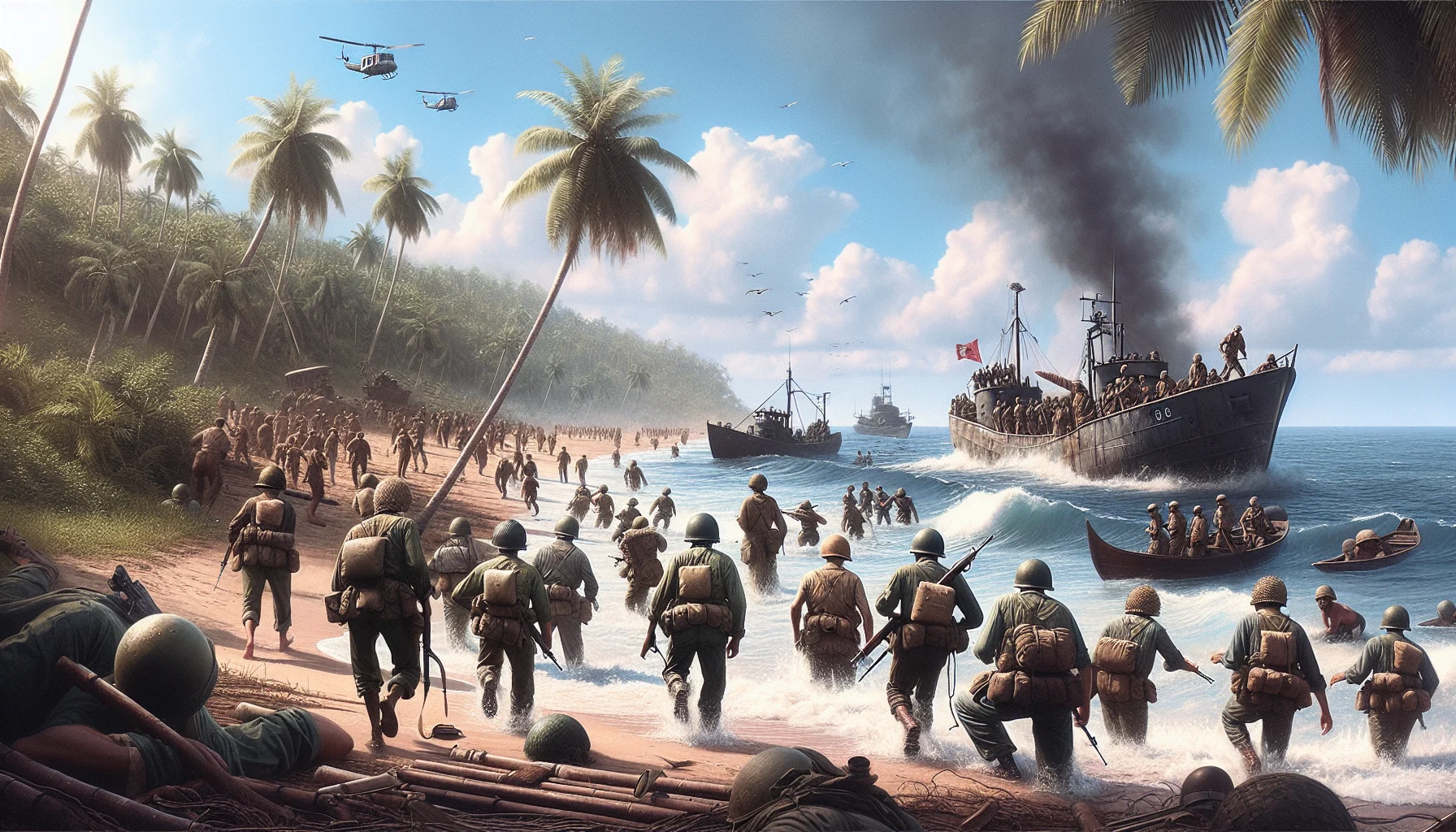
The Bay of Pigs Invasion
by: The Calamity Calendar Team
April 17, 1961
A New Dawn on Hostile Shores
In the sticky heat of April 17, 1961, the coast of Cuba stirred with more than just the rhythm of its ocean tides. This was the Bay of Pigs, a name soon to echo in the halls of power throughout the world. Here, on a serene beach under brilliant blue skies, destinies collided in a high-stakes gambit that would unfold with botched precision. The palm-fringed tranquility hidden behind the name belied the charged tension of an operation veering quickly off course. It was meant to be the tip of the spear, a clandestine strike to topple the socialist linchpin of Fidel Castro's Cuba. Instead, it devolved into a tableau of chaos and miscalculation.
Gathering Storm on the Horizon
The roots of this ill-fated invasion were buried deep in the shifting sands of Cold War animosities. Two years prior, the triumph of Fidel Castro’s revolution had upset the status quo in the Caribbean, dismantling the regime of US-backed dictator Fulgencio Batista. Castro’s new government moved swiftly to nationalize American-owned businesses, alienating its northern neighbor with reformist zeal. Meanwhile, the geopolitical landscape shifted ominously; Soviet influence in Havana grew, seeding fear of a communist domino falling perilously close to American shores.
The Eisenhower administration laid the groundwork to counteract Castro’s ascent, a project inherited by newly minted President John F. Kennedy. Secretly, plans were drawn for a covert operation, one that promised a swift coup by exiled Cuban dissidents trained and armed by the CIA. Yet, like a clock wound from the start to misfire, critical gears had been neglected—gears that began grinding loudly in the days leading up to the landing.
A Prelude of Failures
Before dawn on April 15, the facade of deception frayed. Seven B-26 bombers, painted to mimic rogue Cuban aircraft, strafed airfields in Cuba. This prelude aimed to crater Castro’s air capabilities and incite confusion. But the plan faltered; the element of surprise became tangled in leaks and semi-successful strikes that left much of the Cuban Air Force operational and alert. The world, paying close attention, now watched as tension mounted inevitably and inexorably.
The Ill-Fated Landing
As the morning light on April 17 exposed the Brigade 2506 emerging from the sea, these 1,400 Cuban exiles, flush with hope but thinly armored against reality, found themselves engulfed by an unyielding resistance—Cuban forces which had anticipated their every move. Quickly, logistical cracks widened into chasms: boats sank tongue-tied upon the reefs, supplies dwindled, and the air cover deemed crucial by planners evaporated with a single presidential decision. Kennedy, wary of escalating American involvement, withdrew the promised support.
Expectations crumbled against the grit of Castro’s determined defense; the exiles faced resolute opposition from Cuban soldiers emerging like phantoms from the verdant thicket. The tide had turned more swiftly than even the most cynical voice among American advisors could have forewarned. Then, as initial skirmishes turned into entrenched combat across a 60-square-mile theater, hopes for a popular uprising against Castro evaporated under the coastal sun.
Thanks for subscribing!
Collapse and Capture
By the morning of April 19, it was painfully clear that the long odds had decisively turned. Hunger, fatigue, and fear draped heavily over the insurgents. Still, they pressed on, hoping against the ever-dimming hope for the kind of liberating roar of American bombers. It never came. As the sands soaked up the remnants of ammunition and resolve, surrender became the sole option, save for the few who would vanish or evade capture in small, scattered numbers.
Over 100 were killed; more than 1,100 became prisoners, their captivity a tool for Castro to wield on the international stage. Embarrassment wrapped tightly around the Kennedy administration, for whom the fallout was not just political but ideological. Cuba’s alignment with the Soviet Union solidified, the island itself morphing into the sharp spear point threatening American maritime borders.
Repercussions Echo Through the Years
Castro stood triumphantly, his victory a propaganda boon that amplified his defiance against imperialist America worldwide. For Washington, the reckoning was swift and brutal; sharp critiques aimed at the CIA’s operational failures tore through political circles. Kennedy, owning the disaster, turned toward reinvention—reshaping how clandestine operations would be vetted and managed going forward.
The invasion set the stage for Cold War confrontations that followed, crystallizing with the Cuban Missile Crisis just a year later. The ideological chasm yawned broader, with lines drawn more precisely and no longer so easily crossed by bullet or ballot.
A Legacy of Lessons
With time, the Bay of Pigs has engraved itself in history as a sobering chapter of Cold War derring-do turned debacle. It serves as a monument to misjudgment, studied over time for insights into the fragile art of intelligence, strategy, and international relations. The foibles of human ambition, as proved, were laid uncomfortably bare against the backdrop of pristine sands and relentless waves of the Caribbean. Here, at the Bay of Pigs, history whispers its reminders in salty breezes—that even the most well-worn plans can fall victim to the unpredictable tides of reality.
Stay in the Loop!
Become a Calamity Insider and get exclusive Calamity Calendar updates delivered straight to your inbox.
Thanks! You're now subscribed.